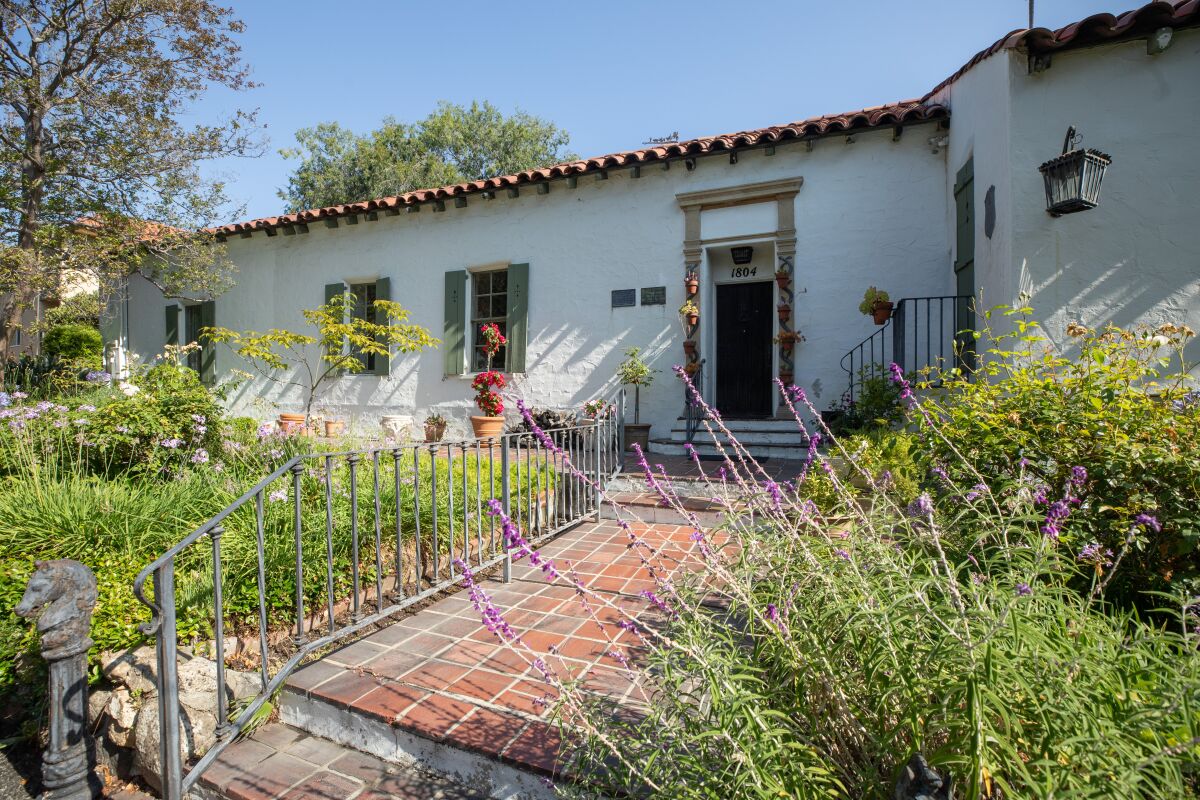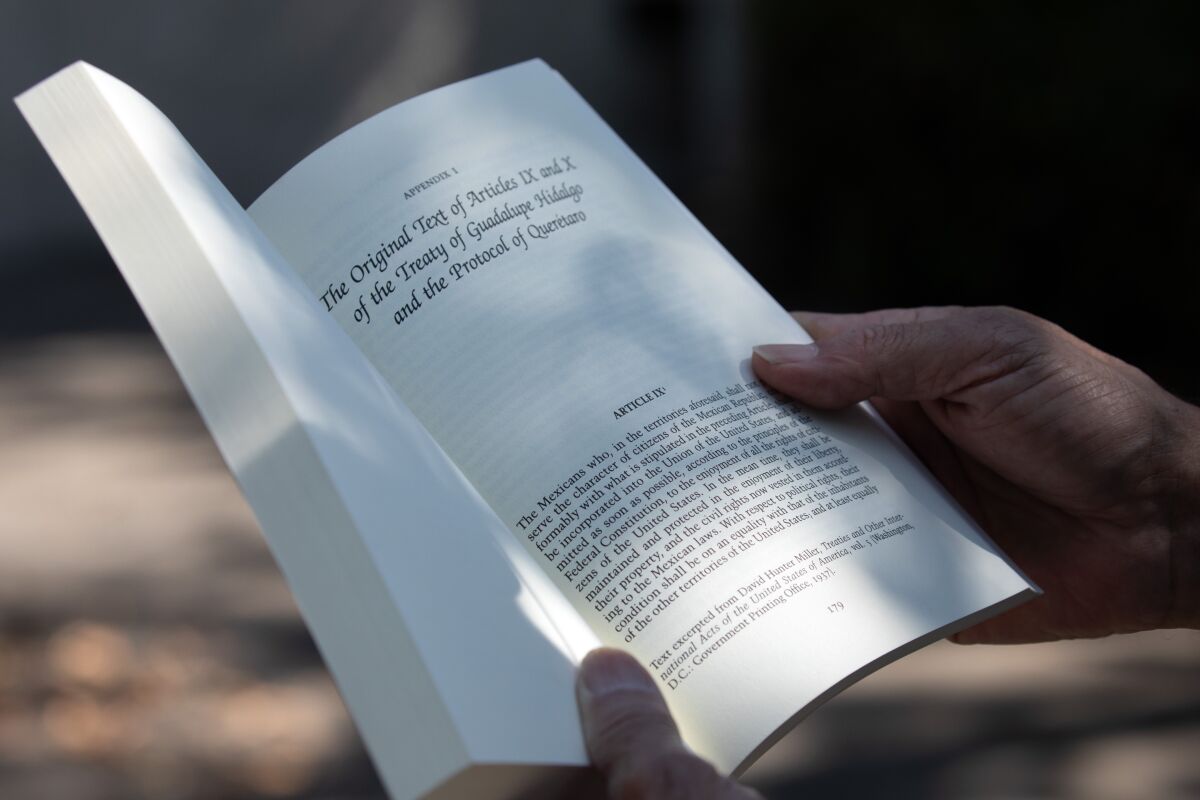Wedged between two cream-colored apartment complexes on a knoll in South Pasadena is a time warp.
The 180-year-old Adobe Flores is one of the last remaining structures from the time that Southern California was part of Mexico. A small grove of palm trees surrounds a cactus garden in the front. To the side is a flagpole with the American flag above the Mexican flag. Bronze plaques on the porch state that the whitewashed one-story building is on the National Register of Historic Places and is where Mexican Gen. Jose Maria Flores stayed before agreeing to a ceasefire in 1847 during the Mexican-American War.
It’s a private residence now, so all I could do when I visited last Saturday morning was stare at it from the driveway. Then, Felix Gutierrez and Lori Fuller Rusch showed up.
He’s a retired USC journalism professor; she teaches art history at Cal State L.A. They’re members of the South Pasadena Preservation Foundation. Together, they took me back to a time when grasslands and cattle covered what today is asphalt and cars, and made the argument that July 4 should mean something more to Southern Californians than just Independence Day.
“This was all open space up to the [110] freeway 50 years ago,” Gutierrez said, waving out to the horizon as we stood in the shade of the palm trees. Two cars sat in the driveway. I wondered if we could go inside.
“The last time the residents allowed us inside was 12 years ago,” he said with a shrug.
On this day 175 years ago, the United States and Mexico proclaimed the Treaty of Guadalupe Hidalgo, ending the Mexican-American War. The agreement established a new border, which meant the northern half of Mexico became the modern-day American Southwest. It also guaranteed to the Mexicans who stayed “the enjoyment of all the rights of citizens of” their new country.
We all know how that worked out.
American history has long treated the agreement as a bump on the road to Manifest Destiny. Mexico, meanwhile, sees it as one of its most humiliating moments. For Mexican Americans, the treaty is a psychic wound that has never healed, proof that the American government — and gringos, by default — can never be trusted.
Activists used its broken promises to organize resistance. In 1972, for instance, the Brown Berets occupied Catalina Island for nearly a month, arguing that since the Treaty of Guadalupe Hidalgo didn’t mention it, they were reclaiming the Island of Romance for Mexico.
Retired USC professor Felix Gutierrez stands in front of Adobe Flores in South Pasadena. The house is on the National Register of Historic Places.
(Myung J. Chun / Los Angeles Times)
I’ve always associated grievance with the treaty. Gutierrez and Fuller Rusch wanted me to see it in a completely different context. He came armed with a folder full of clippings and a book about the history of the treaty; she carried an iPad.
“There’s been a lot of focus on the land that was lost” because of the Mexican-American War, Gutierrez said. “But there should be equal emphasis on the people that remained.”
“We [California] are a microcosm of where the world is going to be,” Fuller Rusch added. “Living together is not always harmonious. So we have to learn from each other and respect each other and fight for each other.”
“And that fight” for Mexican Americans, Gutierrez said as he gestured toward the Adobe Flores, “started right here.”
Gutierrez, whose ancestors came to Southern California in the 1840s, grew up with stories of Californio bravery in the face of American empire. The Mexican government had stripped them of heavy artillery, so all the Californios could fight the “Yankees” (Gutierrez’s term, not mine) with were lances, lariats and pistols.
Those invaders initially “got the rear end kicked out of them,” the profe said with a satisfied smile. The Californios won battles through the fall of 1846 in present-day Dominguez Hills, the San Pasqual Valley in San Diego County and the San Gabriel River near Montebello. But American forces, led by men such as Kearney, Fremont and Stockton, whose last names still pepper the California landscape, were marching on Los Angeles with more men and firepower.

Adobe Flores in South Pasadena. Bronze plaques posted on the porch state that the whitewashed one-story building is where Mexican Gen. Jose Maria Flores stayed before agreeing to a ceasefire in 1847 during the Mexican-American War.
(Myung J. Chun / Los Angeles Times)
Flores and other Californios gathered at an adobe ranch house in Rancho San Pascual, a Mexican land grant that encompassed most of Altadena, Pasadena, South Pasadena and San Marino. Those discussions culminated in the Treaty of Cahuenga, which the Americans and Mexicans signed in modern-day Studio City on Jan. 13, 1847. Decades later, the adobe was named in Flores’ honor.
“Flores told the Americans, ‘If we don’t come to terms, we’ll become guerrilla fighters and flee to the hills,’ ” Gutierrez said. “It’s the only peace treaty in American history dictated by the losing side.”
The armistice allowed Californios to keep their property and promised “equal rights and privileges.” But the Treaty of Guadalupe Hidalgo stripped those guarantees a year and a half later. It’s that loss, Gutierrez said, that we should remember on the Fourth of July, especially since this country has for too long treated Mexican Americans as little better than vassals.
“We [Mexican Americans] have rights as American citizens,” is the Californio message that should still resonate for everyone 175 years later, he said. “We’re just as good as you [Yankees]. Just give us a chance to show it.”
I asked Fuller Rusch what she learned about the Treaty of Guadalupe Hidalgo growing up. “Zero,” she said with a laugh, then added: “It’s one sentence in high school textbooks today. Maybe.”
The profa takes pride in teaching her Latino students about the treaty in classes where she’s “the only gringa in the room. I tell them, ‘Your ancestors are right here, and you should not lose their history, so go find it!’
“The younger they are,” she added, “the less they know — but the quicker they learn.”

The text of the Treaty of Guadalupe Hidalgo is in Richard Griswold del Castillo’s book, “The Treaty of Guadalupe Hidalgo: A Legacy of Conflict.” The treaty ended the Mexican-American War 175 years ago.
(Myung J. Chun / Los Angeles Times)
Fuller Rusch flipped through photos and paintings of Adobe Flores through the decades: as a ranch house, a boarding house, a tea room, an abandoned mess and finally the gleaming slice of California history it is today. She noted that Anglos were the ones who preserved it instead of demolishing it, like too many buildings of the era. The same family has owned it since 1967, holding it as a rental property.
“Others are able to tell its history,” she said. “This is a model for how to live.”
Tenants from nearby apartment buildings blithely walked past Gutierrez and Fuller Rusch as they gave their mini-lecture. Cars drove past us. The happy shouts of families enjoying a picnic bubbled over from nearby Garfield Park.
Gutierrez posed for a photo in front of the flagpole, with its dual national flags, and cracked, “I’ve been waiting 175 years for this moment.”
This story originally appeared on LA Times

